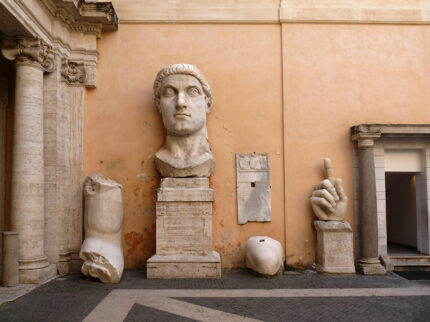
The head, arms and legs of the colossus were carved out of white marble. The body of the emperor, posed seated and enthroned, was made of a wooden framework over a brick core. The body was then bronzed, possibly gilded, in a glittering contrast to the marble extremities. The head alone is more than eight feet high. Extrapolating from the surviving fragments, the intact statue was an astonishing 40 feet high.
The statue was built between 312 and 315 A.D., with the facial features and hands reworked (there are two right hands) around 325 A.D. It was destroyed in Late Antiquity, its bronze looted and melted down, the marble parts broken and abandoned in the ruin of the basilica. The marble pieces were rediscovered in the 1486 and placed in the courtyard of Palazzo dei Conservatori by Michelangelo when he was building Piazza del Campidoglio in 1536–1546.
In 2022, the Factum Foundation in collaboration with the Musei Capitolini and supported by the Fondazione Prada, embarked on a new digitization project to document the fragments and recreate a full-scale replica of the Colossus of Constantine for a new exhibition. In March of 2022, the ten fragments in the courtyard were recorded in ultra-high resolution with photogrammetry and LiDAR technology. The data was used to create a 3D model of the fragments and fill in the missing blanks.
Factum Arte experts worked with museum curators to recreate the statue’s original pose (back when it had one right hand and one left hand) and draping of the paludamentum cloak that covered the emperor’s body. Existing (much smaller) statues of emperors and gods in the same enthroned pose were used as references. By May, the team was ready to go from digital modeling to physical reconstruction.
It was decided to visually distinguish the facsimile fragments from the digitally reconstructed body and cloak.
The recorded digital data of each fragment was rematerialised as 1:1 3D prints, which were used to make positive casts in reinforced resin. The surface was coated with a custom gesso mix and painted to resemble the original marble, weathered by the exposure to the elements. The result was perfect facsimiles of the original fragments.
The recreated sections of the body were made in polyurethane, coated in several layers of resin mixed with marble powder and mica, to achieve a clean neutral marble-white colour. The cloak was made in milled polystyrene, coated with acrylic resin mixed with bronze powder, over which a distressed gold foil gilding was applied.
The final tally was 30 sections of the Colossus. They were craned into the exhibition room at the Fondazione Prada where the statue was assembled for the exhibition Recycling Beauty.
This video gives a glimpse into the digital reconstruction process.
In this video, archaeologist Darius Arya goes into detail about the history of the Colossus, its original context in the Basilica Nova and visits the recreation. It’s awe-inspiring to see the iconic fragments put back together.
* This article was originally published here






No comments:
Post a Comment